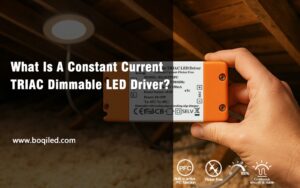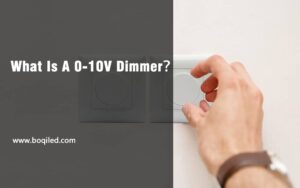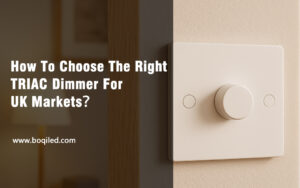LED drivers are essential components in LED lighting systems, responsible for regulating power flow to ensure optimal performance and safety. Understanding the differences between Class 2 and Class II LED drivers is crucial for professionals in the industry, such as engineers, electricians, and lighting designers, as each classification has specific safety standards and applications. Let’s dive into the distinctions between these two types of drivers to help you make informed choices for your LED projects.
What is a Class 2 LED Driver?
Class 2 LED drivers adhere to UL (Underwriters Laboratories) standards, particularly UL1310, which is commonly used in North America. The primary function of a Class 2 driver is to limit output voltage, current, and power to reduce potential risks of electric shock or fire.

- Safety Parameters: Class 2 drivers are defined by strict output limits—typically a maximum of 60 volts DC, 5 amps, and 100 watts. This restriction is designed to minimize any danger of accidental contact with electrical components.
- Touch-Safe: With Class 2 drivers, outputs are considered safe to touch, which means that even if there is a direct exposure to the driver’s output, there is little risk of injury.
- Applications: Class 2 LED drivers are often used in environments where limited power and touch safety are required, such as residential lighting, indoor signage, and decorative lighting. These drivers help meet regulatory standards while providing reliable performance for low-power lighting systems.
What is a Class II LED Driver?
Class II LED drivers follow IEC (International Electrotechnical Commission) standards, which focus more on internal insulation and design safety rather than on limiting output power.

- Insulation Focus: Unlike Class 2 drivers, Class II drivers feature reinforced or double insulation, eliminating the need for grounding. This approach provides a layer of internal protection against electric shock, making the driver safe even without additional earthing.
- Standards Compliance: Class II products are required to meet specific IEC insulation requirements, making them suitable for areas where grounding is impractical or impossible.
- Applications: These drivers are often used in European installations and other regions that prioritize internal insulation over output limitation. Class II LED drivers are suitable for high-insulation environments, including office spaces, commercial buildings, and some industrial settings.

Are LED Lights Class 2 or Class II?
LED lights can be associated with both Class 2 and Class II standards, though they are not interchangeable. A Class II-certified LED light typically has a driver that meets Class II insulation standards, meaning it does not require grounding. However, not all Class II LED lights qualify as Class 2, as they may not limit output voltage or current to the same extent.
This distinction is essential for engineers and electricians to understand because choosing the correct driver type can impact the overall safety and compliance of an installation.
How Do Class 1, Class 2, and Class II LED Drivers Differ?
To provide a broader perspective, here’s a quick comparison:
- Class 1: Generally used for higher power applications, Class 1 drivers require grounding and are often larger, with greater power capabilities.
- Class 2: Limited in output to ensure touch safety, these drivers are ideal for low-power, touch-safe applications.
- Class II: Focuses on internal insulation for safety, does not require grounding, and is often used in European and commercial applications.
Here’s a table summarizing the key differences between Class 1, Class 2, and Class II LED drivers:
| Tính năng | Class 1 LED Driver | Class 2 LED Driver | Class II LED Driver |
|---|---|---|---|
| Primary Standard | UL or IEC | UL (UL1310) | IEC |
| Power Limitation | No strict limitation on output | Limited to 60V DC, 5A, and 100W | No limitation on output power |
| Insulation Requirement | Basic insulation with grounding | Basic insulation | Double or reinforced insulation |
| Grounding Requirement | Requires grounding | Does not require grounding | Does not require grounding |
| Safety Focus | Protects against high-power exposure through grounding | Limits voltage and current for touch safety | Protects against electric shock with internal insulation |
| Typical Applications | High-power or industrial environments | Low-power, residential, and indoor applications | Commercial and European applications where grounding isn’t feasible |
| Common Regions | Global | Primarily North America | Primarily Europe |
Each classification has specific safety features and standards, making them suitable for different environments and regulations.
What Are the Benefits of Using Class 2 and Class II LED Drivers?
Using the right driver ensures compliance and safety. Here’s a summary of the benefits:
- Class 2 Drivers:
- Safe to touch and handle due to limited output.
- Ideal for residential and low-power applications.
- Ensures compliance with UL standards, which is beneficial in North American installations.
- Class II Drivers:
- Offers robust internal insulation, making grounding unnecessary.
- Meets IEC standards, preferred in European and commercial settings.
- Useful in installations where grounding isn’t feasible, maintaining high safety standards.
When to Choose a Class 2 or Class II LED Driver?
Choosing the correct driver depends on the project’s location, power needs, and regulatory standards:
- Select Class 2 if the project requires low output voltage and current for added touch safety, especially in North American residential or indoor environments.
- Opt for Class II when you need enhanced internal insulation and grounding is not feasible, common in European standards and certain commercial applications.
Both driver types provide valuable safety and compliance benefits, making them essential for different kinds of LED installations.
Here’s a table outlining the key differences between Class 2 and Class II LED drivers:
| Tính năng | Class 2 LED Driver | Class II LED Driver |
|---|---|---|
| Primary Standard | UL (Underwriters Laboratories), typically UL1310 | IEC (International Electrotechnical Commission) |
| Power Limitation | Limited to 60V DC, 5A, and 100W to ensure touch safety | No specific power limitation |
| Safety Focus | Limits output voltage and current to minimize shock/fire risk | Focuses on internal insulation to protect against electric shock |
| Insulation Requirement | Basic insulation; does not rely on double or reinforced insulation | Requires double or reinforced insulation |
| Grounding Requirement | Does not require grounding | Does not require grounding due to enhanced internal insulation |
| Typical Applications | Residential, low-power, and indoor applications in North America | Commercial and European settings where grounding isn’t feasible |
| Compliance Regions | Primarily North America | Primarily Europe |
Summary
In conclusion, understanding the distinctions between Class 2 and Class II LED drivers is essential for safe and compliant LED installations. Class 2 drivers limit output power to minimize shock risks, ideal for residential and low-power environments. Meanwhile, Class II drivers offer superior internal insulation without the need for grounding, making them suitable for commercial and European settings. By selecting the right driver type based on your project’s unique requirements, you can ensure optimal safety and performance.







